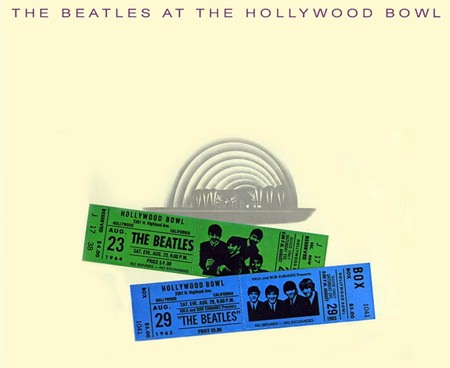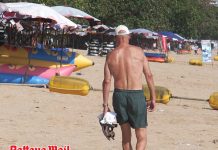
The Beatles: The Beatles Live At The Hollywood Bowl (Capitol/Parlophone)
Like standing behind a Boeing 747 for half an hour while the engine revs, did the Beatles hear anything at all but wave upon wave of shrilling, crazy teenage girls who poured all their locked-up frustrations and orgastic joy of freedom over the four tiny moptops in their matching suits far down there on the stage?
Everything was bigger in the U.S., including the collective madness. This increased the need for space. In 1964 The Beatles shattered the rules for pop concerts. They had no problems selling out 10 000 and 20 000-seat venues, and could have done so many times a day throughout the tour. In 1965 they brought rock music into the sports arenas, filling Shea Stadium in New York with 55,600 wild teens.
The PA systems of the day were not built for this kind of uncontrollable noise. Admittedly no one went to pop concert to experience audiophile delights. Concerts were for watching idols rattle through a handful of hits, with heavy emphasis on “ watching”. But it was simply impossible to hear the Beatles at all in the mayhem.
What was worse, the band couldn’t hear themselves, and it’s pretty tricky when you’re four guys trying to play and sing the same song , preferably simultaneously. The group could hear fragments of their playing through their own amplifiers on stage, but it was worse with the singing as monitors didn’t exist; the microphone signals went through the inadequate local speaker system.
In 1964 it was bad. In 1965 with the bigger venues, it turned catastrophic. That The Beatles tackled these conditions so well is pretty impressive, and it was all due to the fact that they were already an extremely tight and rehearsed live band long before everything took off and the teenagers of the world went insane. They managed to get through these US-concerts on a mixture of sign language, eye contact, lip reading, telepathy and the muddled vibrations of bass and drums – and sometimes the trebly fragments of electric guitars and voices wooshing by when the teenage-tsunami somehow took a deep breath.

Capitol wanted to release a live LP from the 1964 tour. These “souvenirs” were quite common in the U.S. at the time. Neither the Beatles nor Brian Epstein were very happy about it, but accepted that the Hollywood Bowl show August 23, 1964 was to be taped. Capitol hoped for a live-album for Christmas. But when George Martin heard the recordings he put his foot down. As expected, the girl shrills were threatening to drown out the music. Martin regarded the recordings useless. Capitol reluctantly shelved the project, however a snippet of “Twist And Shout “ from the Hollywood Bowl-concert was included on “The Beatles Story” album, released in November 1964.
A year later Capitol was at it again and taped both Hollywood Bowl concerts (August 29 and 30, 1965). And yet again George Martin blocked the project. A TV documentary from the groundbreaking concert at Shea Stadium in New York, August 15, went ahead, though. George Martin was not happy with the sound as usual and went for massive “cheating” before he approved the film.
Several of the songs were treated to extensive overdubbing in London in early January 1966 – “I Feel Fine” and “Help!”were even completely re-recorded. It must have been the strangest studio sessions The Beatles ever did, the performances were reamshackle on purpose to make them sound real. They didn’t bother with re-recording “Act Naturally “ but used the studio version from “Help!” instead. As the Shea Stadium version is much faster, Martin had to speed it slightly up and do a series of bizarre edits to get it in sync with the film. The documentary premiered on the BBC in May 1966.
The Hollywood Bowl-tapes lay gathering dust in the Capitol archives until the small record label Lingasong managed to stear clear of all EMI’s attempts to stop them and released a double album of very poor sounding live recordings taped in Hamburg in December 1962 (“Live! at the Star-Club in Hamburg, Germany; 1962”). In order to kill this inferior album EMI decided to release the Hollywood Bowl-recordings after all. George Martin did some heavy remixing and put together a decent program of 13 songs picked from both tours. “The Beatles Live At The Hollywood Bowl” hit the shops in early May 1977 and managed to top the UK album charts.
1977 – the year of the Sex Pistols, The Clash, The Jam, Elvis Costello – punk and new wave battling it out with disco and pretentious arena-dinosaurs like ELP and Yes. Elvis Presley dying in the midst of it all. It was modern times, rock music going rapidly through changes. And out of the blue, there they were, The Beatles, topping the charts with some highly irrelevant live recordings from the stone age. It was weird. Even I thought so. Believe me, I normally love to see my heroes at No. 1, but this was embarassing. The album had no business outselling recent offerings from ABBA, Eagles, 10CC, Stranglers, Clash, ELO, Fleetwood Mac, Bob Marley, Pink Floyd, Tom Petty & The Heartbreakers, Dr. Feelgood and Peter Gabriel. But it did.
Over the years, however, I learned to appreciate its existence and I am willing to kowtow for every single boss in London’s EMI offices to get it out on CD. Hollywood Bowl kills two birds with one stone. Firstly, the album is a unique historical document, Beatlemania caught at its absolute peak. We are peeping into a moment in history so unique that there had never been anything like it before and would never be again.
One thing is the madness – an entire world’s focus on one phenomenon, one band. But zooming out you’d find that this moment also includes the Vietnam War, the Civil Rights movement in the United States, the aftermath of the Kennedy assassination, the sudden and huge generation gap opening to the thunder of electric guitars, the naivety of everyday life, the flickering black and white TV-screens. Just let your associations flow. Stack it up. And everything revolves around this axis: The Beatles caught alive on three crazy August evenings in 1964 and 1965.
Secondly the album smashes the myth of the Beatles as a mediocre live band to smithereens. The Rolling Stones love to keep that myth alive, even today. But The Hollywood Bowl recordings prove them all wrong. The Beatles were simply stunning live. People seem to forget that they were originally a sharp and punchy guitar combo playing blistering rock’n’roll based on the American stuff they listened to and adored as youngsters. But they refined and developed the music into something entirely different and definitely their own, and it pours out of them with a confidence that borders on the divine.
Remember, this precedes “Rubber Soul” and “Revolver” and “Strawberry Fields”, this was before they became geniuses and gurus, this was the early period, the light period, the years of bustle, hustle, madness, press conferences, photo shoots, TV-performances, radio recordings, movies, concerts, concerts, concerts, a state of constant mental bloodletting that should have pushed them into a collective creative collapse. How was it possible to deliver as they do on this runaway train? And not just deliver. Sparks fly as The Beatles, the guitar combo, charge through the hurricane on their heavymetal thunder, occasionally taking detours into the playfully elegant and highly melodic, another Beatles speciality.
It is a miracle that they’re able to deliver under these conditions. They can hardly hear each other, but the collective that was The Beatles takes any obstacle as a challenge, and proves their greateness with gusto. I even dare to claim that in 1964 and 1965 they were the world’s greatest live band. And also the coolest.
The metallic and hard hitting brutality of “Ticket To Ride” and “She ‘s A Woman “ is outstanding. And the live version of “Dizzy Miss Lizzy” is no longer a cover, but a rock’n’roll monster going straight for your throat.
The Beatles avoid the tunes in their catalogue that incorporate complicated vocal arrangements, they would never have worked here. But they bravely punch their way through songs where the classic two part-singing of John and Paul is crucial, demanding total presence and timing from both of them, namely in the aforementioned “Ticket To Ride”, plus “Things We Said Today”, “A Hard Day ‘s Night” and “Help!”. When they can’t hear each other, their eyes lock, and sparks fly. Amazing.
The only song that smacks of tour of duty is “She Loves You”, at this point in their career it must have felt like a novelty number, but they still nail it without turning it into a slice of self-parody.
The bass and drums are tightly interlocked here, a necessity as they are the only thing faintly audible to the guitar players through the waves of high pitched human noise threatening to flatten everything around them and tear their eardrums to pieces. Lennon’s rhythm guitar is metallic and sharp as a razor, his whipping chords pushes some of the songs into heavymetal territory, long before the term was invented.
Harrison suffers the most under the circumstances, his solos don’t quite match the elegance of the studio versions. He’s a bit sloppy, choosing shortcuts if things get too complicated and never daring to break free from his original blueprints, probably because he can’t really hear much of what he’s doing anyway. Yet Harrison ads a lot of muscle when he slips back to playing chords, boosting the rhythm and giving John’s heavymetal-chops an alluring counterpoint of country.
Some out of tune singing can be spotted, but you can’t blame them for that. In this turmoil it is a miracle that they hit any right notes at all, and mostly they hit them astonishingly well .
One should also remember that this is a real live recording without any embellishment, no cheating, no overdubs. Just The Beatles as they were in 1964 and 1965, wrinkles, warts and all. This is how they sounded live on stage. If anybody had been able to hear them.
The chat between the songs is enjoyable, they mostly adress each other as the noise makes communication with the audience next to impossible, the in-jokes are delightful and their reactions to the madness that surrounds them precious.
The only thing you can hold against the album is of course the solid wall of shrills. It is not comfortable on the ear, and although George Martin tried to balance it, it is there all the time, like the sound of an airplane, or the sound of 10,000 girls caught in a collective orgasm lasting for 30 minutes. Exhausting stuff.
“The Beatles At The Hollywood Bowl “ has never been officially released on CD. It’s a shame.
Released: May 1977
(All tracks written by Lennon–McCartney, except where noted)
Side One
1.”Twist and Shout” (Phil Medley and Bert Russell) (30 August 1965) – 1:32
2.”She’s a Woman” (30 August 1965) – 2:53
3.”Dizzy Miss Lizzy” (Larry Williams) (29/30 August 1965) – 3:37
4.”Ticket to Ride” (29 August 1965) – 2:51
5.”Can’t Buy Me Love” (30 August 1965) – 2:16
6.”Things We Said Today” (23 August 1964) – 2:20
7.”Roll Over Beethoven” (Chuck Berry) (23 August 1964) – 2:28
Side Two
8.”Boys” (Luther Dixon and Wes Farrell) (23 August 1964) – 2:12
9.”A Hard Day’s Night” (30 August 1965) – 3:15
10.”Help!” (29 August 1965) – 2:46
11.”All My Loving” (23 August 1964) – 2:14
12.”She Loves You” (23 August 1964) – 2:31
13.”Long Tall Sally” (Enotris Johnson, Richard Penniman, and Robert Blackwell) (23 August 1964) – 2:53
Produced by:
Voyle Gilmore (original recordings)
George Martin (cleanup and mixing for 1977 release)
 |
 |
 |





